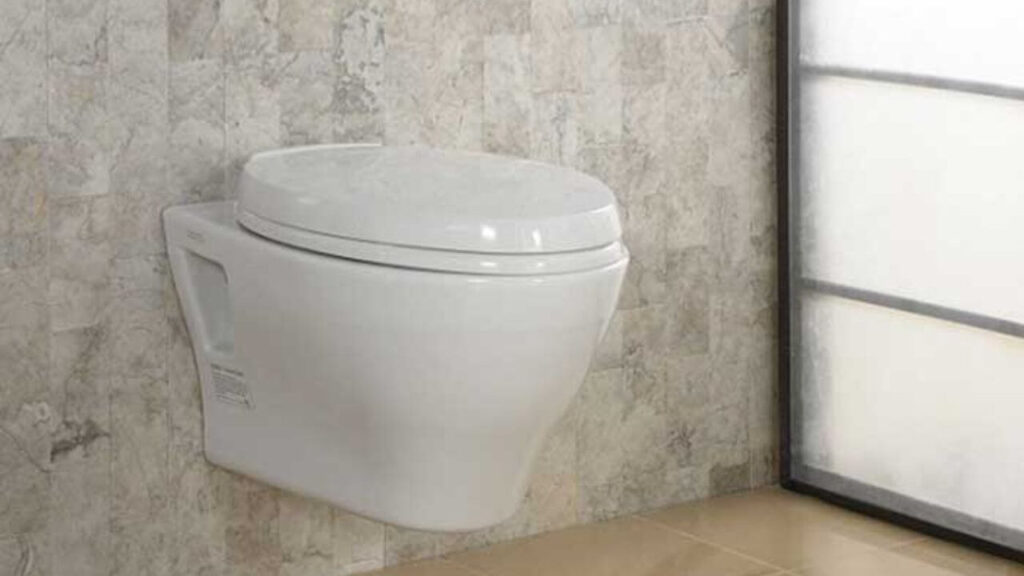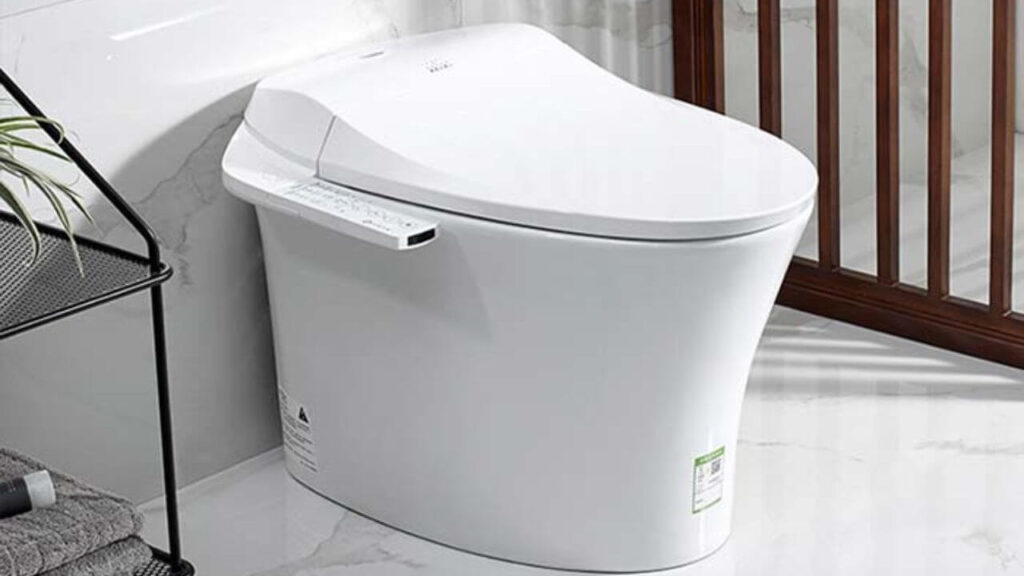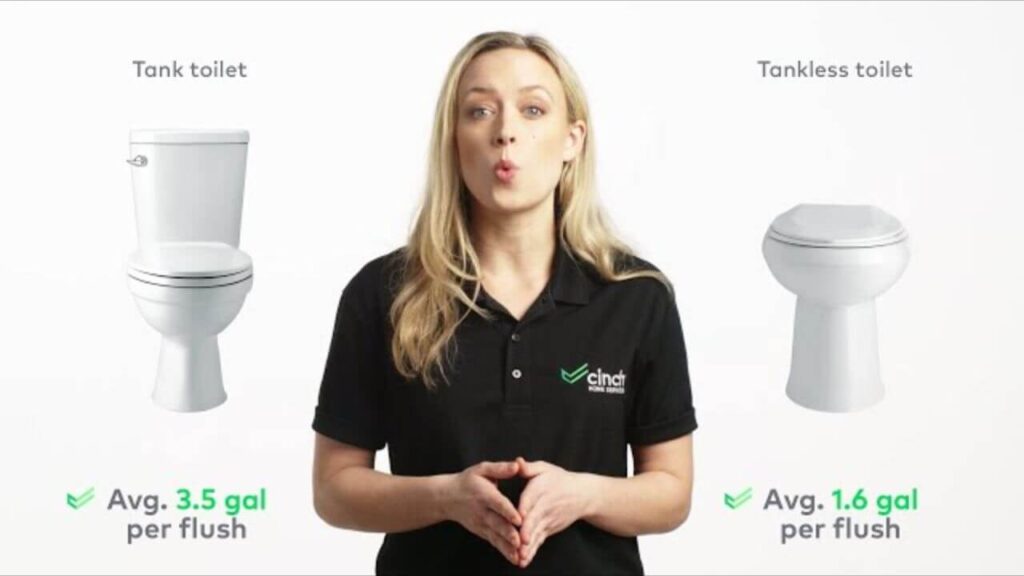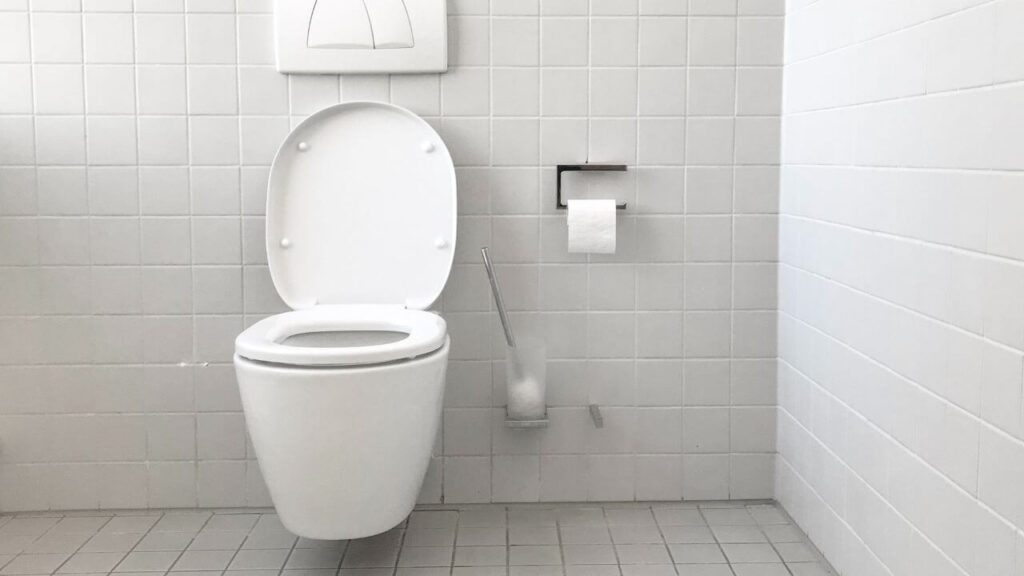Hey there, fellow plumbing enthusiasts! Today, we’re diving into the intricate world of tankless toilets, a marvel of modern plumbing ingenuity.
Imagine a toilet that lacks the conventional tank but packs a punch regarding flushing efficiency.
Get ready to explore the nitty-gritty details of how these innovative fixtures operate.
From their direct water connections to their smart utilization of electric pumps, we’ll unravel the mystery behind their space-saving design and impressive flushing power.
So, roll up your sleeves and join me in this exploration of tankless toilet mechanics – it’s a journey worth taking for any plumbing aficionado!
A Tankless Toilet | An Overview

A tankless toilet is a modern plumbing fixture that operates without a traditional water tank. Instead, it directly connects to the water supply line and uses pressurized water to create a powerful flush.
This innovative design eliminates the need for a bulky tank, making tankless toilets a space-saving and water-efficient option.
They offer quick refills and customizable flush volumes and are suitable for commercial and residential use. Some models require power from an electric pump, while others rely solely on water pressure.
Tankless toilets represent a contemporary approach to waste disposal, combining efficient mechanics with a sleek and functional aesthetic.
Also Read:
What Is A Japanese Toilet | What’s Interesting About It
Is Eljer a Good Toilet | Everything You Need To Know
What Is Bio Toilet | A Comprehensive Guide In 2023
How Do Tankless Toilets Work?

So now you know what a tankless toilet is, here is the time to understand how this little beast works.
Tankless toilets, use pressurized water directly from the supply line to rapidly flush waste through a valve mechanism.
This efficient design eliminates the need for a traditional water tank, offering quick and effective flushing without refilling delays. Here’s a detailed explanation of how they work:
1. Direct Water Supply
Tankless toilets connect directly to the building’s main water supply.
This connection ensures a constant and consistent flow of pressurized water to the toilet whenever needed.
Unlike traditional toilets that rely on a tank to store water, tankless toilets draw water directly from the supply line.
2. Flush Mechanism
When you activate the flush mechanism, usually by pressing a button or a lever, a valve known as a flushometer opens.
The flushometer is responsible for controlling the release of water from the supply line into the toilet bowl.
3. Pressurized Flush
The water released by the flushometer enters the toilet bowl with significant force due to the pressurized nature of the water supply.
This force creates a rapid and powerful flush that clears waste and debris from the bowl and down the drain.
4. Rapid Refill
After flushing, the flushometer valve closes, halting the flow of water. The toilet bowl refills quickly, preparing the toilet for the next use.
The rapid refill ensures the toilet is available again within a short timeframe.
5. Water Efficiency
Tankless toilets are designed to be water-efficient. They use only the precise amount necessary to achieve an effective flush.
Unlike traditional toilets with fixed tank volumes, tankless toilets offer the flexibility to adjust the water release based on the specific needs of each flush.
6. Commercial and Residential Use
Initially popular in commercial settings like public restrooms, tankless toilets have also made their way into residential bathrooms.
They offer a sleek and modern design while providing efficient waste disposal. Their compact size is particularly advantageous in smaller bathrooms.
7. Power Requirement
Some tankless toilets require a power source to operate, typically an electric pump that assists in generating the flush force.
However, non-powered tankless toilet models rely solely on the water pressure from the supply line, making them more energy-efficient.
Special Features Of Tankless Toilets
Certainly, let’s explore the special features of tankless toilets in more detail:
1. Air Purification
Some advanced tankless toilets are equipped with built-in air purification systems.
These systems help neutralize odors by using filters and technology to clean the air within the bathroom, creating a more pleasant and fresh environment.
2. Motion Detector
Tankless toilets with motion detection technology can sense when a user approaches or leaves.
This feature can trigger the toilet to open the lid automatically, flush it, and close it afterwards, providing a hands-free and hygienic experience.
3. Self-Cleaning Function
Certain tankless toilets come with self-cleaning functions.
These toilets have automated cleaning mechanisms that can clean the bowl, sanitize surfaces, and ensure a clean toilet after every use, reducing the need for manual cleaning.
4. Toilet Seat Heating
Well, this one is my favorite. Tankless toilets often feature heated seats for enhanced comfort, especially during colder seasons.
Users can adjust the seat temperature to their preference, creating a more pleasant experience, particularly in chilly environments.
5. Spray Massage
Some tankless toilets offer a spray massage feature, which provides a gentle and refreshing water spray for personal hygiene.
This feature can be customized regarding water pressure, temperature, and spray pattern, enhancing user comfort and cleanliness.
6. Remote Control
Remote-controlled tankless toilets provide convenient operation at your fingertips.
Using a handheld remote control, users can control various functions, such as flushing, seat heating, water temperature, and bidet features.
Also Read:
10 Amazing Toilet Water Saving Tips You Need To Know
Why Install A Tankless Toilet?

I know at this point, many of my readers would be thinking that why install this modern toilet while having the traditional one is okay right?
Well, let me tell you Installing a tankless toilet offers several benefits:
1. Space-Saving
Tankless toilets have a streamlined design that eliminates the need for a bulky water tank.
This compact form factor is particularly advantageous for smaller bathrooms or areas with limited space.
By taking up less physical space, tankless toilets allow for more efficient bathroom layouts and create a more open and spacious feel.
2. Water Efficiency
Tankless toilets use precise water for each flush, unlike traditional toilets that release a fixed volume from the tank.
This water-efficient design helps conserve water resources, reduces your household’s water consumption, and can lead to cost savings on water bills over time.
3. Continuous Water Supply
Tankless toilets are directly connected to the main water supply, ensuring a continuous flow of pressurized water whenever you flush.
This reliable water supply translates to consistent and powerful flushing performance, preventing issues often associated with fluctuations in tank water levels.
4. Modern Aesthetics
Tankless toilets feature a sleek and contemporary design that complements modern bathroom aesthetics.
Their clean lines, absence of a visible tank, and minimalist appearance can add a touch of sophistication to your bathroom decor, enhancing its overall visual appeal.
5. Quick Refills
The absence of a tank means that tankless toilets don’t need to refill a reservoir after each flush.
As a result, they offer rapid refills, reducing the waiting time between flushes and ensuring that the toilet is available more quickly.
6. Adjustable Flush Volume
Some tankless toilets allow you to adjust the flush volume based on the type of waste being disposed of.
This flexibility lets you conserve water for liquid waste and use a higher volume for solid waste, maximizing the toilet’s efficiency while maintaining effective waste removal.
7. Commercial or Residential Use
Tankless toilets are versatile and can be installed in various settings, from residential homes to commercial establishments like offices, restaurants, or public restrooms.
Their adaptability makes them suitable for a wide range of bathroom environments.
8. Energy Efficiency
While some tankless toilets require power from an electric pump, others rely solely on water pressure, making them more energy-efficient.
This can be especially relevant for eco-conscious individuals looking to reduce their carbon footprint.
Also Read:
Why Does Flushing The Toilet Affect The Shower
Why Can’t You Flush Toilet After Drug Test
Who Should Install A Tankless Toilet?
Installing a tankless toilet is a decision that suits various preferences and needs, depending on factors like space availability, efficiency goals, and design preferences.
Here’s a detailed breakdown of who should consider installing a tankless toilet:
1. Homeowners with Limited Space
Tankless toilets are a boon for spaces where every inch matters.
In apartments, small bathrooms, or compact powder rooms, the absence of a tank allows for efficient space utilization.
This design choice can create a more open and less cluttered environment, making tankless toilets an optimal solution for those seeking to maximize the available room.
2. Water-Saving Enthusiasts
Tankless toilets align with water conservation efforts. Unlike traditional toilets with a fixed amount of water stored in a tank, tankless models offer customized flush volumes.
This adaptability ensures that only the required amount of water is used for waste removal, which can significantly reduce overall water consumption.
This feature is a compelling reason for environmentally-conscious individuals to opt for a tankless toilet.
3. Utility Bill Conscious Individuals
Lowering utility bills is a priority for many. Tankless toilets contribute to this goal by efficiently managing water usage.
By consuming less water per flush, they help reduce water expenses over time.
This financial advantage and their functional benefits make tankless toilets a cost-effective choice.
4. Modern Aesthetics Admirers
Tankless toilets offer a contemporary and sleek appearance that complements modern interior design.
Their streamlined and minimalistic profile enhances the visual appeal of a bathroom.
For those who value aesthetics and desire a bathroom with a chic and uncluttered look, a tankless toilet can be a style-forward addition.
5. Sustainable Businesses
Commercial establishments aiming to adopt eco-friendly practices find tankless toilets fitting. Their water-efficient operation aligns with sustainability initiatives.
This is particularly relevant for businesses seeking LEED certification or those aiming to portray an environmentally responsible image to customers, clients, and employees.
6. Plumbing-Adept Individuals or Businesses
While some tankless toilets come with straightforward installation instructions suitable for DIY enthusiasts, others might necessitate professional plumbing expertise.
Individuals or businesses comfortable hiring a plumber can confidently choose tankless toilets, ensuring correct installation and optimal functionality.
7. Innovation Seekers
Tankless toilets represent a departure from conventional toilet designs.
For those intrigued by modern technology and innovative solutions, the unique mechanics of tankless toilets can offer a sense of novelty and forward-thinking design in their living spaces or commercial settings.
Also Read:
What’s The Biggest Thing You Can Flush Down A Toilet?
Can I Use Toilet Paper As Gauze
Can You Retrieve Something Flushed Down Toilet
What To Look For When Buying A Tankless Toilet?
So people who are impressed by this modern tankless toilet and thinking of having it in their bathrooms.
So for those, here are the factors that I prefer you to be aware of when buying a tankless toilet.
1. Water Efficiency
Opt for a tankless toilet that offers adjustable flush settings or dual-flush functionality.
These features allow you to customize the water volume based on the type of waste, maximizing efficiency and water conservation.
Look for models with a WaterSense certification that meet water-saving standards.
2. Flush Power
The toilet’s ability to provide a strong and effective flush is a crucial factor.
Research user reviews and checks product specifications to ensure that the toilet you’re considering can efficiently remove waste and prevent clogs.
Look for details about the flushing mechanism and innovative technologies enhancing flush performance.
3. Installation Requirements
Determine whether the tankless toilet requires a power source, as some models use electric pumps for flushing.
Additionally, check if any specialized plumbing is needed for installation.
If you’re comfortable with DIY projects, ensure that the installation process aligns with your skills. Otherwise, be prepared to hire a professional plumber.
4. Space and Design
Measure your bathroom space and choose a tankless toilet that fits comfortably without overcrowding.
Consider the bowl shape (round or elongated) and the exterior design to match your bathroom aesthetics.
A tankless toilet’s sleek and compact design can be especially beneficial for smaller bathrooms or those with a modern design theme.
5. Brand and Quality
Research reputable brands with a history of producing reliable and durable plumbing fixtures.
Established brands often prioritize quality, offering products built to last and backed by reliable customer support.
6. Maintenance and Cleaning
Evaluate how easy it is to clean and maintain the tankless toilet.
Look for features such as a smooth glaze on the bowl that resists staining and a design that minimizes crevices where dirt and grime can accumulate.
Check if replacement parts are readily available for repairs or maintenance.
7. Budget
Set a budget range before shopping and explore options within that range. Consider features, quality, and long-term savings when determining the value of the toilet.
Remember that while water savings and durability might justify a higher upfront cost, finding a balance that fits your financial situation is essential.
8. Warranty
Look for tankless toilets that come with a solid warranty. A warranty assures that the manufacturer stands behind the product’s quality.
Pay attention to the terms and duration of the warranty to ensure you’re covered in case of any issues.
9. User Reviews
Reading user reviews and testimonials can provide insights into real-world experiences with the toilet.
Pay attention to feedback about flush performance, durability, ease of installation, and customer service to gauge the overall satisfaction of previous buyers.
10. Professional Installation
If the tankless toilet requires professional installation, consider the associated costs when deciding.
Hiring a licensed plumber ensures correct installation and helps avoid potential problems in the future.
Also Read:
What To Do When Toilet Paper Holder Keeps Falling Off Wall?
What To Do If You Clog a Hotel Toilet
How Do You Flush A Tankless Toilet?

Ultimately, I will teach you how to flush this modern piece. Don’t worry! Flushing a tankless toilet is a straightforward process:
Step 1: Press the Flush Button or Handle
Locate the flush button or handle, which is typically situated on top of the tankless toilet.
This button or handle is the control mechanism that initiates the flushing process.
Press the button or lift the handle gently to activate the flush.
Step 2: Wait for the Flush
Once you’ve pressed the flush button or handle, the flushometer valve inside the tankless toilet opens.
This valve allows pressurized water from the water supply line to flow into the toilet bowl.
Take a moment to observe as the water flows into the bowl.
Step 3: Observe the Flush
As the pressurized water enters the toilet bowl, it does so with force.
The rapid and forceful water flow creates a powerful flush that propels waste and debris through the trapway and into the drain system.
This dynamic flushing mechanism is a key feature of tankless toilets.
Step 4: Release the Button or Handle
Release the flush button or handle once satisfied with the flush and the waste has been effectively cleared from the bowl.
This action prompts the flushometer valve to close, immediately stopping the water flow into the bowl.
Step 5: Bowl Refill
Following the flush, the tankless toilet refills the bowl with water. The refill process starts promptly after the flushometer valve is closed.
Tankless toilets generally have a quick refill rate, ensuring that the toilet is ready for use again quickly.
Step 6: Verify the Water Level
After the bowl has been refilled, visually inspect the water level.
Ensure that the water level is appropriate for proper functionality and future flushes. The water level should be neither too high nor too low.
Step 7: Adjust as Needed
Some tankless toilets offer adjustable flush settings. Depending on the model, you can customize the flush volume based on the type of waste being disposed of.
Refer to your toilet’s manual for instructions on adjusting the flush settings if applicable.
Step 8: Maintenance
To ensure consistent and effective flushing performance, regularly clean the tankless toilet.
This includes cleaning the bowl, rim jets, and other components susceptible to mineral buildup or debris accumulation.
Remember that tankless toilets rely on a direct water supply and a pressurized flush mechanism so the flushing experience may feel different compared to traditional gravity-fed toilets.
As with any new fixture, it’s advisable to refer to the manufacturer’s instructions specific to your tankless toilet model for the most accurate and effective flushing process.
Also Read:
How To Flush A Tankless Toilet Without Water | 2 Ways
How To Flush Toilet Without Running Water?
How To Flush Toilet | 14 Ways | A Comprehensive Guide
Bottom Line
A tankless toilet uses a direct water supply and an electric pump to create flush force, offering space-saving and efficient design.
While installation costs and power dependency are factors, it represents a modern approach to efficient waste disposal.
